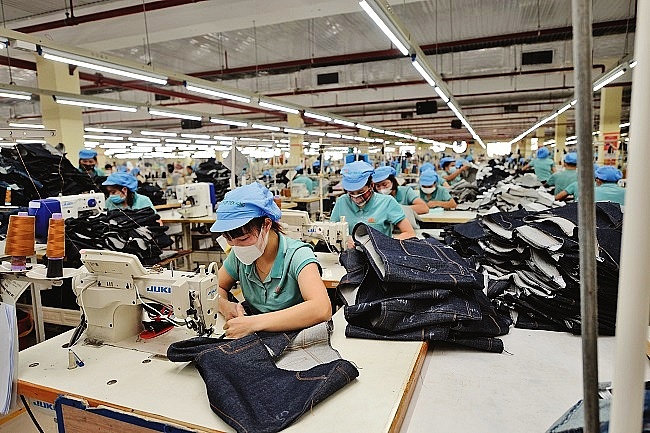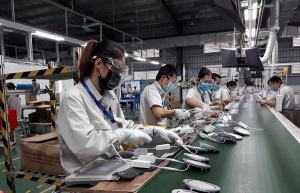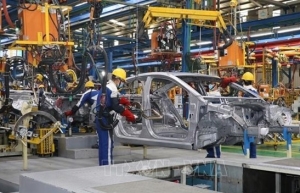Hill still to climb for industrial production targets to be met
Since Q4 of 2022, Hanoi Textile and Garment Materials JSC has been faced with a 30 per cent reduction in outputs, while operational costs have increased by 15 per cent.
 |
| Hill still to climb for industrial production targets to be met, Source: baodautu.vn |
“We’re using about 500 workers, instead of 700 before, and we may have to continue our cutbacks this month or April if the situation cannot get better,” said vice director Nguyen Viet Thang.
“Our revenue also reduced by 20 per cent in Q4 of 2022 and the rate was down by 10 per cent in the first two months of this year,” Thang said.
The company has been unable to import materials from China, which is the biggest material provider, while domestic partners are also shrinking production. In addition, the company is now burdened by paying high lending rates of 15 per cent a year for bank loans.
This company’s plights can be seen in a recent survey conducted by the General Statistics Office over 6,500 manufacturing and processing enterprises nationwide, the surveyed firms stated that they are facing massive difficulties both at home and in export markets.
“In the previous quarter, the biggest two difficulties hitting enterprises’ performance were high lending rates and low demands in the global markets,” stated the survey.
Thirty-five enterprises of respondents said they suffered from high lending rates in Q4, while the rate for Q3 sat at only 23.5 per cent. Similarly, 32.6 per cent of respondents reported low demands in global markets in Q4, far higher than 26.7 per cent in Q3.
When it comes to inventory of finished products, 17.1 per cent of respondents predicted a rise in Q1 of 2023 as compared to Q4 of 2022, and up to 52.4 per cent projected no change in Q1 of 2023 against Q4 of 2022.
It is forecasted that this situation will linger into the next quarters, according to the GSO.
“Overall, the Russia-Ukraine conflict; high inflation in the US, UK, and EU; the US policy on semiconductor development; and continued geopolitical tensions in some regions in the world are the main causes affecting of businesses’ performance, in which foreign-invested enterprises have been suffering the most,” the GSO said.
For example, in August 2022, the US Congress passed the CHIPS and Science Act, a law that approves subsidies and tax breaks to help jump-start the renewed production on American soil of advanced semiconductors. Just two months later, the Biden administration issued wide-ranging restrictions on the export to China of chips and chip-making technology to undercut that country’s ability to manufacture the same class of integrated circuits.
Fitch Ratings last month reported that Samsung Electronics operating profit plummeted by 69 per cent on-year in Q4 of 2022 to due to a memory-chip price decline and weak consumer electronics sales that were worse than Fitch Ratings expected amid bleak consumer sentiment. This caused 2022 operating profit to fall 16 per cent from the previous year.
Samsung Vietnam exported $65 billion worth of products last year, down 0.8 per cent from 2021. The company’s exports accounted for 17.48 per cent of Vietnam’s total export turnover of $371.85 billion last year, and 8.87 per cent of the nation’s total trade turnover of $732.5 billion.
In another case, Nguyen Van Minh and another 1,300 workers at a Japanese-invested company based in Hanoi’s Thang Long Industrial Park have been working in moderation since last October. This is the second time the company has faced such a plight, after previous restrictions in 2020.
“Previously we could have three days working overtime voluntarily, with a total of 12 hours a day, with more money to cover our living expenses. However, over the past five months, we have been unable to do that. The company’s production cannot increase due to difficulties in sales,” Minh said. “It was expected that the company would import some lathes in Q4 of 2022 for production expansion, but no plan has been implemented.”
The company has three big workshops manufacturing vehicle clutches, and other spare parts for the automotive industry to supply to Japanese companies both in Vietnam and overseas.
“Since Q4, the economy’s growth momentum and industrial production have slowed, in addition to a reduction in the country’s export and import markets,” stated Minister of Planning and Investment Nguyen Chi Dung.
In its March forecasts for Vietnam, global analysts FocusEconomics stated, “Industrial output will grow 3.6 per cent in 2023, which is down 2.4 percentage points from last month’s forecast, and expand 8.1 per cent in 2024.”
According to the GSO, Vietnam’s index of industrial production (IIP) for the first two months of 2022 declined 6.3 per cent on-year, partly due to the Lunar New Year taking place in January when many industrial businesses halted production. However, over the first two months of the previous year, the IIP increased 5.6 per cent.
After rising only 6.3 per cent on-year in October 2022, the IIP bounced back to 18.38 per cent in November before decreasing to 7.31 per cent in December. It increased merely 1.06 per cent on year in January 2023 and climbing 3.6 per cent on-year in February.
According to the Asian Development Bank (ADB), although the overall business environment in Vietnam has improved so far, business momentum has started to slow and the registration of new firms declined even though the accumulated number of new firms increased. The decline nevertheless reflects challenges in the business recovery; for example, labour shortages, and lower numbers of new orders.
“The country’s economic outlook continues to face heightened risks. The slow delivery of planned public investment and social spending, especially the implementation of the government’s economic recovery and development programme, could slow growth this year and next,” the ADB said.
However, Tim Leelahaphan, economist for Thailand and Vietnam at Standard Chartered Bank, commented that he believed the economic situation is gradually improving, while also citing Standard Chartered’s forecast that the nation’s GDP growth could reach 7.2 per cent this year and 6.7 per cent next year.
“Although the Vietnamese economy still faces some macro risks such as inflation, public debt, and confidence on economic recovery, the outlook for recovery should be positive in the second half of 2023,” Leelahaphan said. “Vietnam continues to be an important link in the global supply chain and an attractive destination selected by many businesses.”
 | Industrial production recovers quickly with growth of 9.4 percent in eight months The index of industrial production (IIP) in the first eight months of 2022 surged 9.4 percent over the same period last year, according to the General Statistics Office (GSO). |
 | Index of industrial production enjoys impressive growth The index of industrial production (IIP) in the first 11 months of 2022 is estimated to increase by 8.6 per cent year-on-year, doubling the 4.2 per cent of the same period last year. |
What the stars mean:
★ Poor ★ ★ Promising ★★★ Good ★★★★ Very good ★★★★★ Exceptional
Related Contents
Latest News
More News
- Sustainability a core value for DKSH’s vision (January 07, 2026 | 16:00)
- People encouraged to contribute and grow at AstraZeneca Vietnam (January 07, 2026 | 15:48)
- Dat Bike accelerates sustainable mobility (January 07, 2026 | 15:24)
- Innovation to support modern healthcare development (January 07, 2026 | 10:00)
- Six localities record double-digit growth as regional performance diverges in 2025 (January 06, 2026 | 18:00)
- E-commerce market undergoes transformation amid rising competition and regulation (January 06, 2026 | 17:54)
- Vietnam’s industrial output hits seven-year high in 2025 (January 06, 2026 | 17:47)
- GELEX’s credit rating outlook upgraded to 'Positive' by VIS Rating (January 06, 2026 | 16:49)
- Finance sector lays firm groundwork for 2026 after major reform (January 06, 2026 | 15:30)
- Vietnam’s seafood exports surpass $11 billion in 2025 (January 06, 2026 | 08:51)

 Tag:
Tag:




















 Mobile Version
Mobile Version